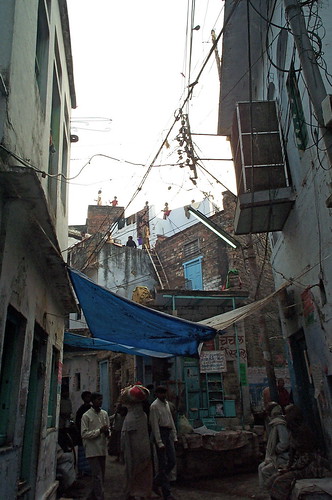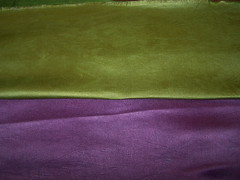 Today, I used acid dyes to color a couple of pieces of silk satin for my thangkas. I don’t have a top-loading washing machine, so I had to go with the stove top method. And since I only have one pot big enough to allow the silk to swim freely, I did one color at a time. That’s okay; I managed to prepare and eat lunch at the same time, keeping all the chemicals separate from my food and my hands.
Today, I used acid dyes to color a couple of pieces of silk satin for my thangkas. I don’t have a top-loading washing machine, so I had to go with the stove top method. And since I only have one pot big enough to allow the silk to swim freely, I did one color at a time. That’s okay; I managed to prepare and eat lunch at the same time, keeping all the chemicals separate from my food and my hands.
Heavy silk satin is the material I use most in my thangka work. I still have a lot of material that I bought in Varanasi years ago, when I still lived in India. But I’ve run out of my favorite colors, and especially of the sky and ground colors. I’ve tried ordering materials from India remotely, but have found I often don’t get quite what I ask for.
Here are some old photos from my silk-buying trips in Varanasi. The first is the street leading to my supplier’s showroom and the second is me and my friend Anie poring over the choices:


Since this heavy satin is mostly used for bridal gowns in the West, the color choices are limited — white, off-white, ivory, cream, champagne, bone… Okay, you can find a few other colors — mostly the colors of bridesmaids‘ dresses — but still not enough for my purposes. And the material is extremely expensive! Plus, I like the idea of creating my own colors. SO I’ve been trying to dye some ready-for-dyeing silk satin I bought a few years ago from the Silk Connection.
I had previously tried using fiber reactive Procion dyes in cold water with soda ash. I have a German friend here in Italy who has produced wonderful results with these dyes on cotton. And I got some pretty colors on my silk samples too — though completely different from her cotton colors — but the surface of my satin changed. See the before and after photos below and click to get an enlarged view from my Flickr page:
I lost the smooth, tight finish and the consistent luster. Unsure whether it’s the soda ash or simply the result of soaking this fabric in water, I decided to try acid dyes which are more specifically suited to animal fibers such as silk and wool. (Procion dyes, though they can be used on silk, are better for plant fibers… or so I’ve read.)
SO today I used Jacquard Acid Dyes and white vinegar, along with a water softener (Milan water is VERY hard) and Synthrapol for pre- and post- rinsing. My work is drying now… The colors are gorgeous. I’m waiting with fingers crossed to see how the surface texture and sheen come out. Will let you know!




you can use the procion dyes just like the acid dyes.. in another words instead of the soda ash you use white vinegar. I believe the reason you lose the sheen is the soda ash breaks down the fibers and softens them, to enable the absorption of dye.
Have you tried dyeing silk with a product called Jacquard Preset….there is no hot water necessary. One merely paint the Jacquard dye on, let it dry over night then rinse the fabric with the Jacquard permanent dyeset concentrate (for wool and silk). It is more for defined areas and not yardage.
Also dyeing in a small pan … you might be creating permanent wrinkles in the fabric with the mixture of heat and moisture. I might try painting it on with a big brush or another wad of fabric. then put in that preset dye stuff. NOW, you make me want to use some satin silk for a hanging I want to make. I made them for my side light windows in china silk and after 5 years they deteriorated. I had made a cartoon for the original one so I can easily do it again. Wished I had taken pics.
Thanks Deb! No, I haven’t tried Jacquard Preset. Sounds like it’s worth an experiment. I’ve also been advised to try painting with the acid dyes and then steam setting. But if there’s a color that can be set without heat or steam, so much the better! The color just has to be fixed well enough that it doesn’t rub away as I work it in my hands, stitching intensely. With iron-set silk paints, I had that problem.
Anyway, so far I’ve come to the conclusion that the soda ash was not the culprit. I got the same puckering with acid dyes in a hot bath. Not from the tight space but from some breaking down of the warp threads. (see my posts “Puckered Satin” and “Update on the Dyeing Experiments“. I’m still working on this and will keep you posted. Thanks for the input!